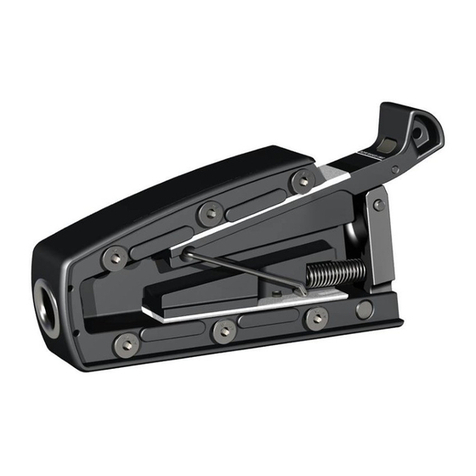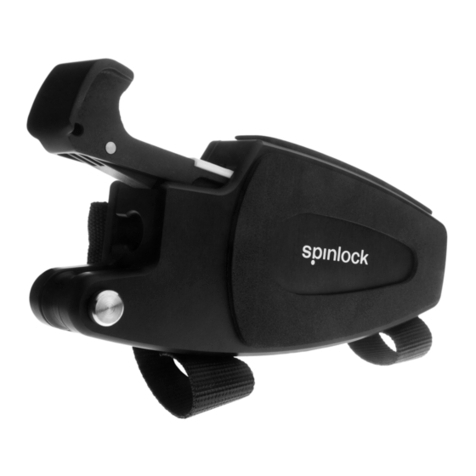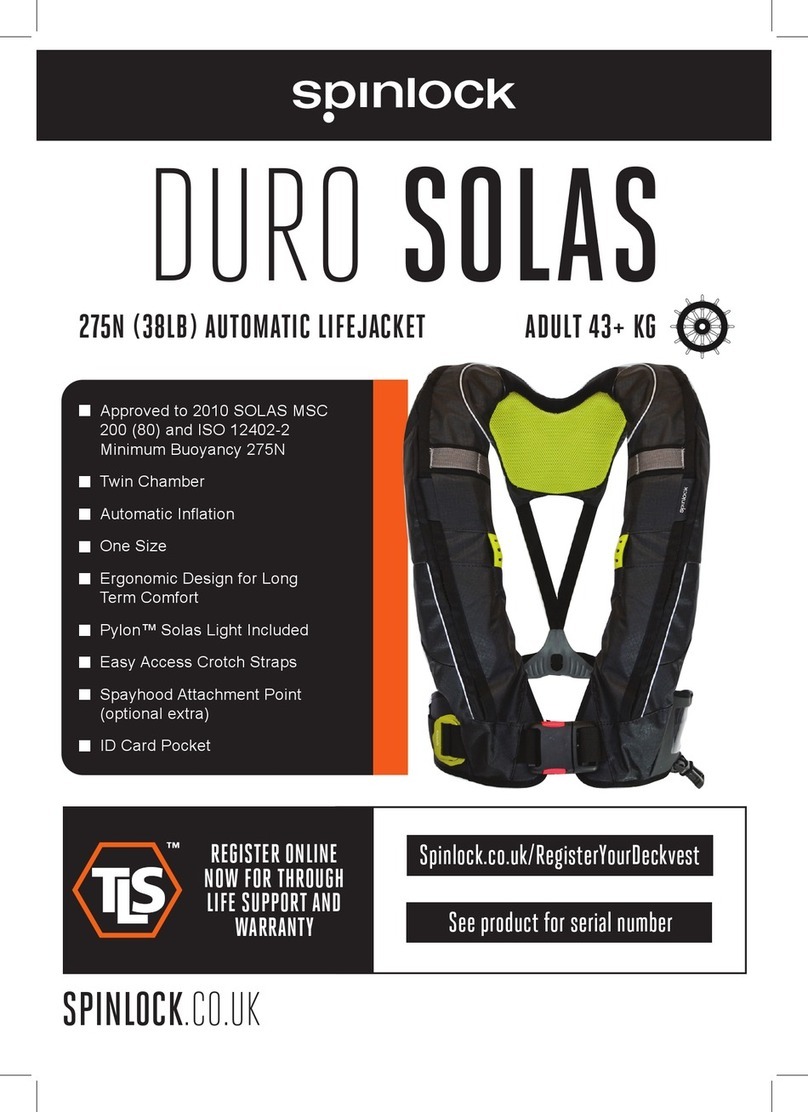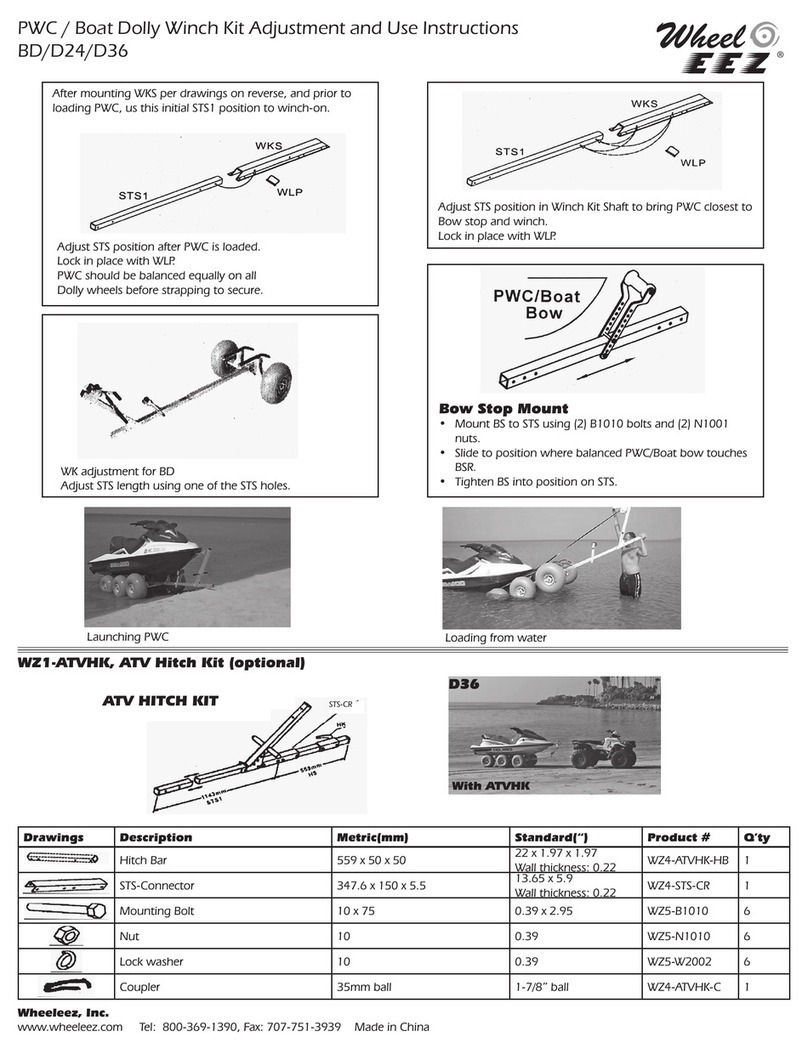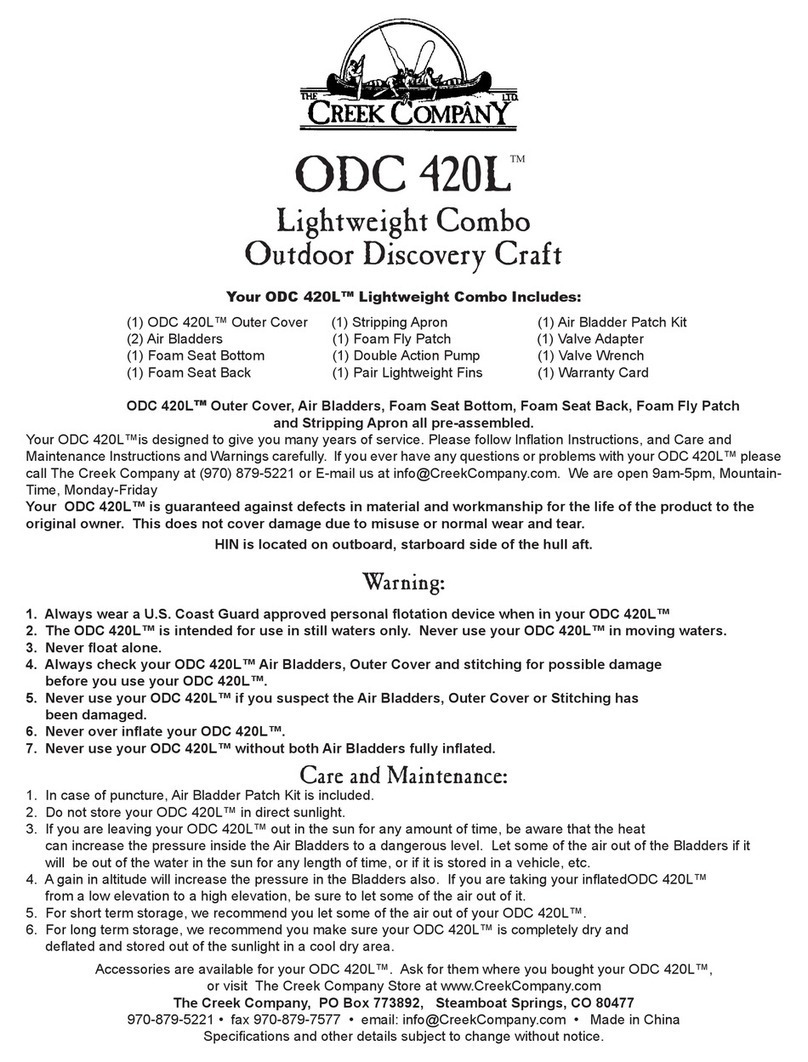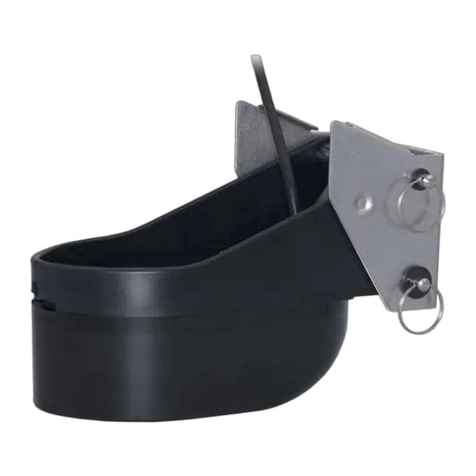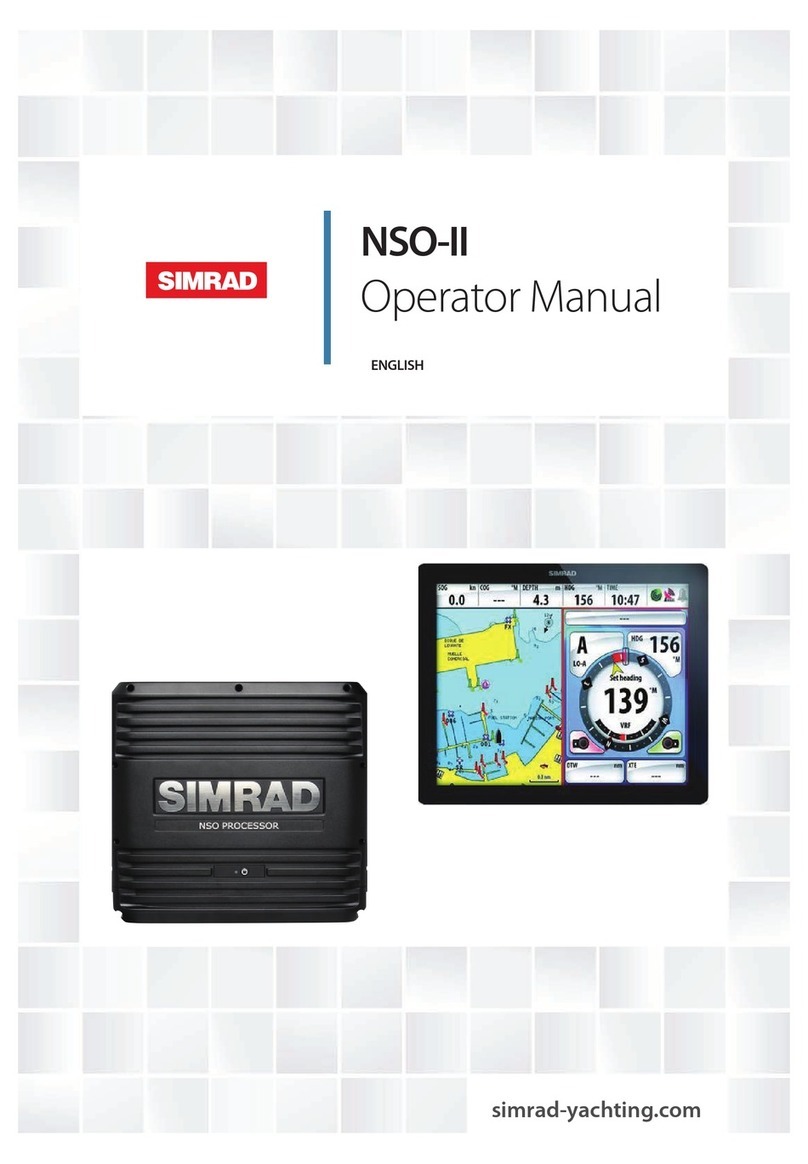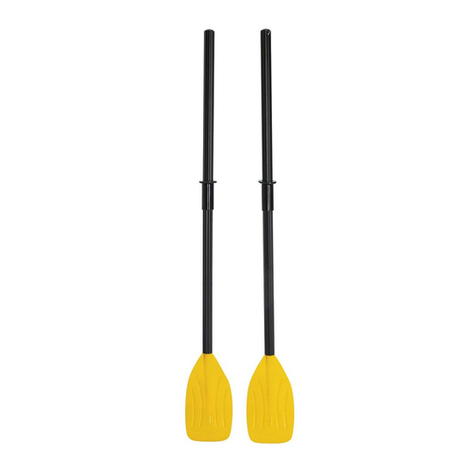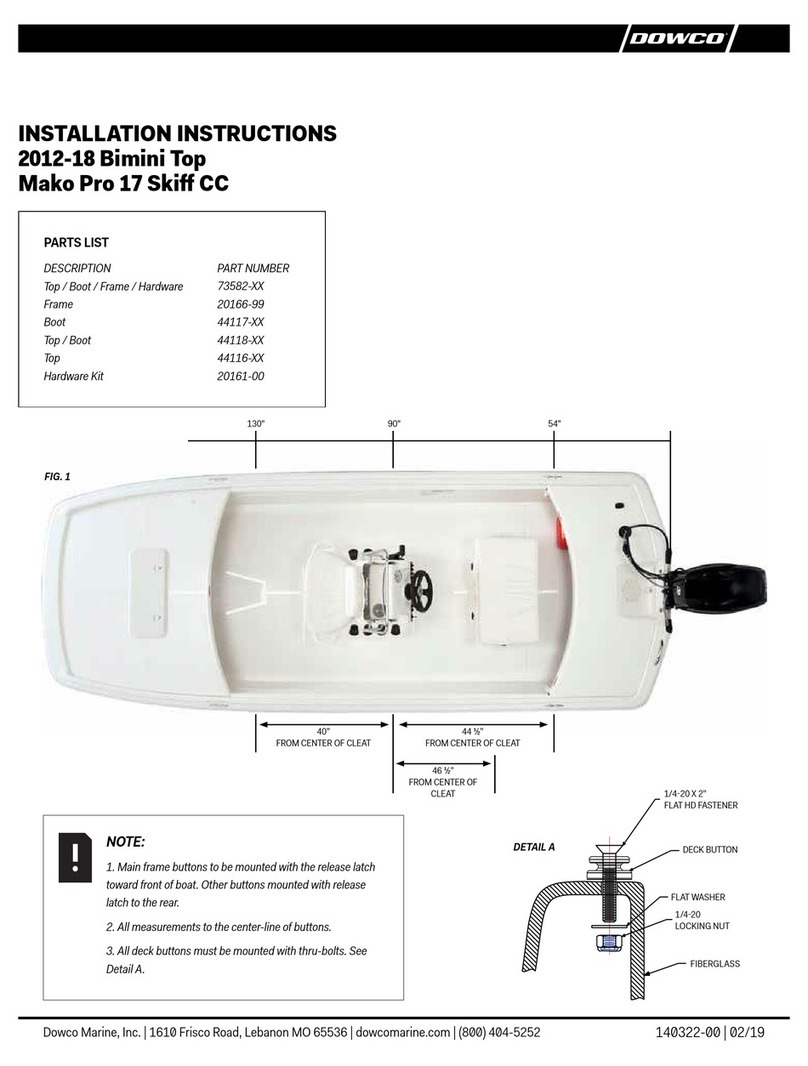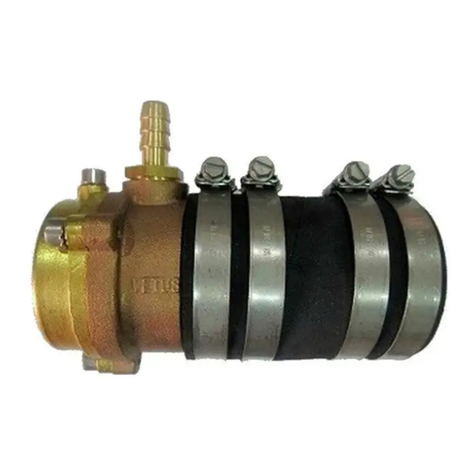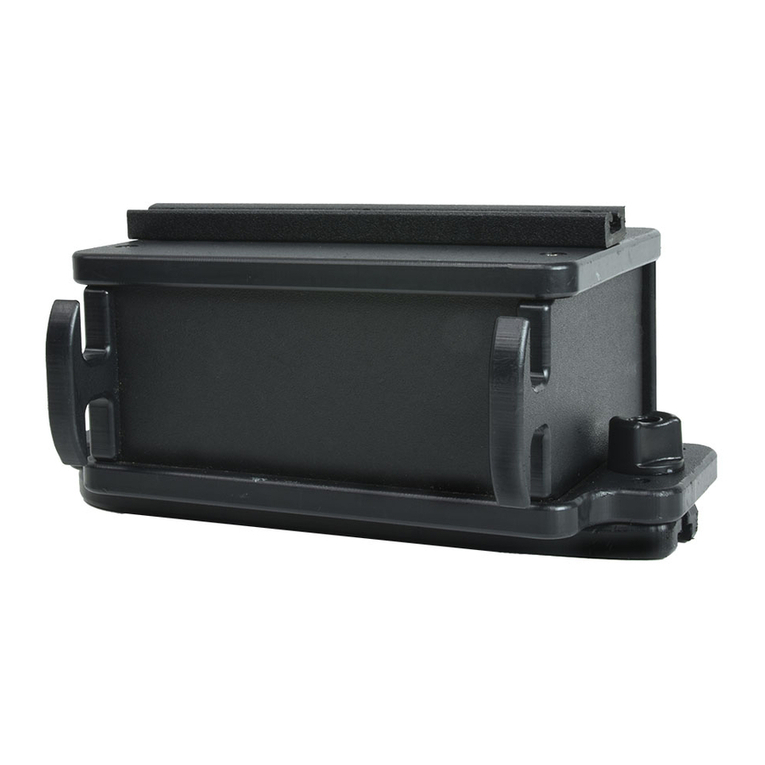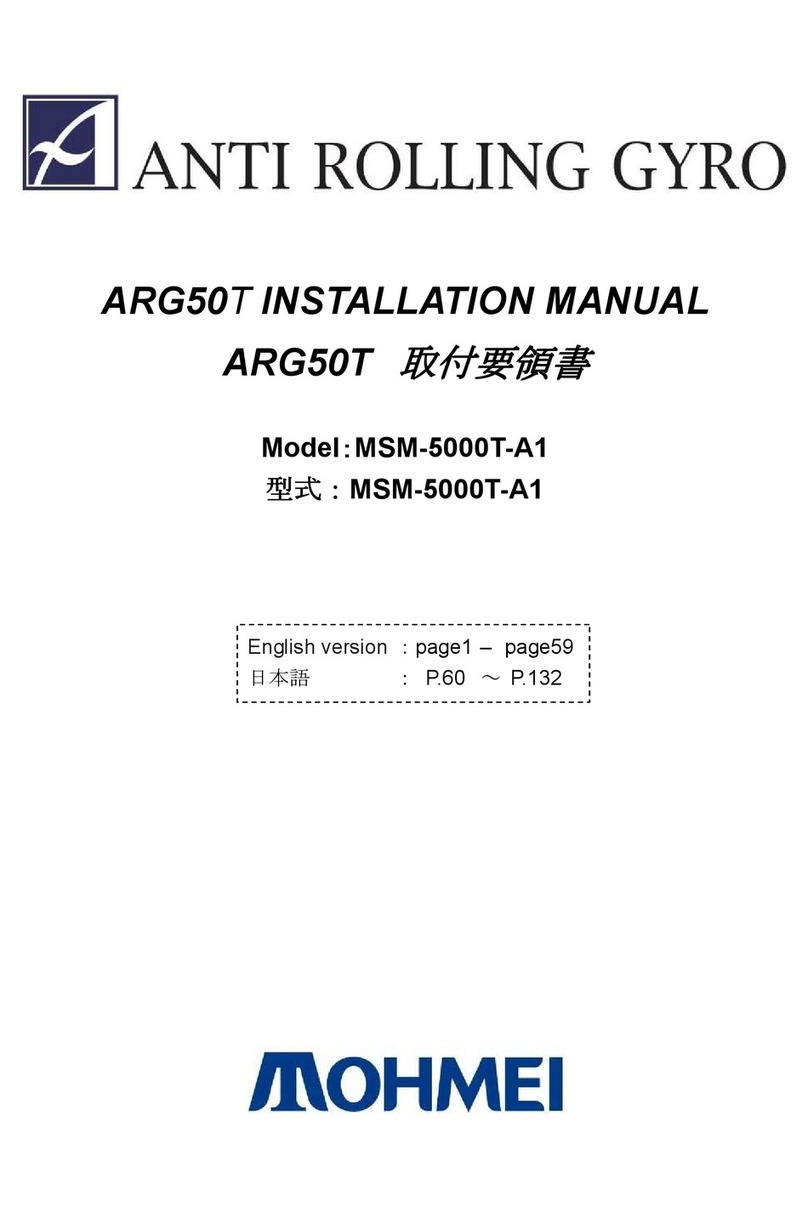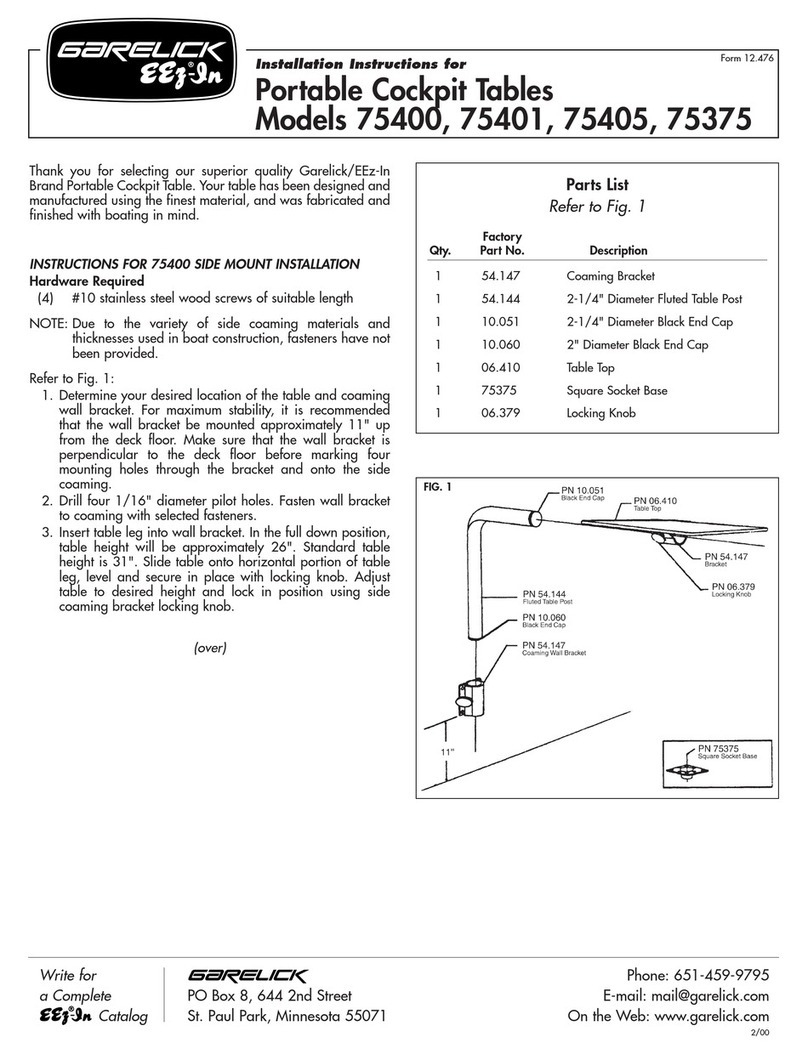Spinlock Deckvest VITO User manual

APPROVED TO CE EUROPEAN
& ISO INTERNATIONAL
STANDARDS
LIGHT WEIGHT + COMPACT
AUTOMATIC INFLATION
SPRAYHOOD + PYLON™ LIGHT
LUME ON™ LIFE JACKET
ILLUMINATION
170N (38lb) & 275N (62lb) Automatic Lifejacket with
Hydrostatic inflator and integral Deck Harness
www.spinlock.co.uk
3R903A_4 - Deckvest Vito Instruction Book.indd 1 27/08/2019 11:26

Pylon™ Light with a unique
23cm elevation - activates
upon contact with water.
Sprayhood, to prevent
inhalation of sea water.
Manual activation handle.
Whistle.
Automatic inflation - Latest
Hammar®Hydrostatic automatic
firing head designed to activate
when submerged. Visual
indicator shows the ‘armed’
status of the cylinder and the
firing head.
1
2
3
4
5
6
7
8
9
10
11
Automatic Lifejacket (170N or 275N) with integral Deck Harness
Preset Belt Adjustment
Safety line attachment loop.
Contoured crotch strap.
Chest pack attachment points.
Lifting Loop.
Lume On™ lifejacket
Illumination
- Water activated
- Minimum 2hrs flashing
at full intensity
- 5 year shelf life
1
4
5
11
2
10
3
9
7
8
6
1
3R903A_4 - Deckvest Vito Instruction Book.indd 2 27/08/2019 11:26

2
Fitting and Adjusting your Deckvest
12 3 4 5 6
1 23 4 5 6 1 2 3 45 6
1 2 34 5 6
Check size
Adjust waist belts to correct size
XS, S, M, L, XL, XXL
1 2 3 4 56 1 2 3 4 5 6
Ensure buckle is threaded
through the correct way
3R903A_4 - Deckvest Vito Instruction Book.indd 3 27/08/2019 11:26

3
Crotch Strap
4
Crotch strap
can be stored
in rear pocket
L
I
F
T
H
E
R
E
L
I
F
T
H
E
R
E
L
I
F
T
H
E
R
E
L
I
F
T
H
E
R
E
L
I
F
T
H
E
R
E
L
I
F
T
H
E
R
E
Sprayhood
Lifting / Buddy Loop
Clip together at front
3R903A_4 - Deckvest Vito Instruction Book.indd 4 27/08/2019 11:26

4
Hammar®Inflator
Oral
Inflation
Firing Head
Auto
AB A B
Green
Red
Manual
Whistle Location - Blow to operate.Opens from breakout point
3R903A_4 - Deckvest Vito Instruction Book.indd 5 27/08/2019 11:26

5
To deflate the lifejacket, invert
the oral-inflation tube end cap
and insert it into the valve.
Gently squeeze the lifejacket
until all air has been expelled.
1. AB C D E F
Lifejacket Repacking
A B C D EF
Re-attach zips on side with firing head.
A B C DE F
Run this slider round to the
firing head side.
A BC D E F
Pull zips out.
ABCDEF
Start running zip back
round to close.
A B CD E F
Separate zip chain at yellow end section.
3R903A_4 - Deckvest Vito Instruction Book.indd 6 27/08/2019 11:26

6
YKK
YKK
YKK
YKK
3. Run zip
round to top.
4. Run zip down
to close.
2. Concertina bladder onto
itself ensuring a smooth flow
for the manual lanyard.
Check cylinder is
tight and firing
cap is secure.
Sprayhood Repacking
1.
Place jacket on its back
and lay the sprayhood out
2.
Concertina top of sprayhood
3.
Turn jacket over on its front and start to bend hoop
section in on itself and push down into the back of jacket
4.
Push Sprayhood hoop
down to bottom of pocket
YKK
YKK
3R903A_4 - Deckvest Vito Instruction Book.indd 7 27/08/2019 11:26

7
GRANTED US PATENT
FLASH INTENSITY : 0.75 CANDELA MINIMUM
FLASH RATE : 50-70 PER MINUTE
ACTIVATION : AUTOMATICALLY IN WATER
APPROVALS : Latest SOLAS/MED
EXPIRY : 5 year life. Product should be checked and
serviced regularly. Replace at expiry date.
The Spinlock Pylon Light is extensively protected under various National, European and
International Patents and Design Rights owned by Spinlock Ltd.
For continuously updated user guidance go to www.spinlock.co.uk
Turns on
automatically
when in water
automatically
when out of water
Press and hold button
to test light
Can be returned to
Spinlock for recycling
or at a WEEE
collection point
Light
On/Off
Battery
Check
3R903A_4 - Deckvest Vito Instruction Book.indd 8 27/08/2019 11:26

8
Contents
Page no:
Pylon Light 7
Approval conditions 8
Re-arming your Deckvest 8
Inflating, deflating and testing your Deckvest 9
Maintaining your Deckvest 10
Instructions for use 11-53
Inspection record sheet 54
Spinlock Deckvest
This Deckvest is an integrated lifejacket and harness approved to ISO 12402-3 (150N) or
ISO 12402-2 (275). Minimum Buoyancy 170N or 275N.
It is important to get into the habit of wearing your Deckvest. It is comfortable, safe and
a pleasure to wear.
A lifejacket harness only works correctly if it is fitted and secured correctly.
Inflatable lifejackets only become buoyant when inflated: they contain no inherently
buoyant materials.
Practice and training are required with this device before use. As user, it is your personal
responsibility to understand the operation and maintenance requirements of your
inflatable lifejacket and be familiar with its limitations.
Approval conditions:
This Deckvest is an integrated CE approved lifejacket according to ISO 12402-3 (150N) or ISO
12402-2 (275) and a CE approved Integrated Deck harness according to ISO 12401.
Re-arming a Deckvest
Follow Hammar Re-arming Instructions. Only approved Spinlock Deckware re-arming kits
should be used.
Hammar®- Part No: DW-RAH/V170 - 33g cylinder DW-RAH/V275 - 60g Cylinder
WARNING:
The deck safety harness and safety line may transmit very large forces. Only
attach to strong hooking points or jack-lines.
The deck safety harness and safety line are intented to prevent the user falling
overboard. They do not provide protection from falls at height.
It is unsafe to wear this harness loose, the harness shall be worn tightly in
order to be effective.
GRANTED US PATENT
FLASH INTENSITY : 0.75 CANDELA MINIMUM
FLASH RATE : 50-70 PER MINUTE
ACTIVATION : AUTOMATICALLY IN WATER
APPROVALS : Latest SOLAS/MED
EXPIRY : 5 year life. Product should be checked and
serviced regularly. Replace at expiry date.
The Spinlock Pylon Light is extensively protected under various National, European and
International Patents and Design Rights owned by Spinlock Ltd.
For continuously updated user guidance go to www.spinlock.co.uk
Turns on
automatically
when in water
automatically
when out of water
Press and hold button
to test light
Can be returned to
Spinlock for recycling
or at a WEEE
collection point
Light
On/Off
Battery
Check
3R903A_4 - Deckvest Vito Instruction Book.indd 9 27/08/2019 11:26

9
Inflating your Deckvest
It is recommended that the following inflation procedures are followed:
1. MANUAL INFLATION
To manually inflate the lifejacket, sharply pull the rubber handle downwards.
The CO2gas cylinder should inflate the bladder within seconds.
2. ORAL INFLATION
To inflate the lifejacket by mouth, locate the oral inflation tube by opening the zip at
the back of the lifejacket. Then after removing the end cap, blow into the tube until the
lifejacket is fully inflated.
3. AUTOMATIC INFLATION
Inflation should occur automatically within seconds of the inflator unit being
submerged. The automatic capsule is designed to activate a sprung pin to puncture the
CO2cylinder and inflate the bladder.
CO2Cylinder size: Model 170N: use 33g Model 275N; Use 60g
INFORMATION: PRESSURE VARIANCE
With variations in air or water temperatures, topping up by oral inflation may be
required to maintain full buoyancy especially after prolonged immersion.
Deflating the lifejacket
To deflate the lifejacket, invert the oral-inflation tube end cap and insert it into the valve.
Holding the cap firmly in this position, gently squeeze the lifejacket until all air or gas has
been expelled. Return the cap to its normal position.
Testing your Deckvest
You should always test the inflation of your lifejacket to ensure you are aware of how it
functions. This can be done with the Oral, Manual or Automatic inflators.
If you are a weak swimmer it is strongly recommended to use an automatic lifejacket or
an inherently buoyant device.
1. Put on the Deckvest and adjust to fit.
2. Stand in shallow water, just deep enough for your head to be above the surface.
3. Inflation: Automatic: lifejacket should inflate within five seconds of head being
submerged at the required depth.
Manual: lifejacket can be activated by a sharp pull on the inflation handle.
Oral inflation: Ensure cylinder and firing head are removed before entering
water. Open lifejacket cover from zip breakout point, locate oral inflator,
remove cap and blow through tube.
4. After testing completely deflate the lifejacket using the oral inflator and dry
Deckvest thoroughly.
WARNING: Using the CO2inflation when your jacket is already fully inflated
can over-pressurise and damage your lifejacket.
3R903A_4 - Deckvest Vito Instruction Book.indd 10 27/08/2019 11:26

10
Maintaining your Deckvest
Maintaining this Deckvest should be the responsibility of one sole user. As the user you are
strongly advised to familiarise yourself fully with the Deckvest before using it as a lifejacket.
We advise that you follow a 3-level checking routine, easily carried out yourself:
1. During use, check buckles and other fastenings regularly.
2. Before and after use, examine for damage or excessive abrasion, wear, tear or
contamination. Particular attention must be paid to the stitching and webbing,
including the less accessible areas.
3. Every three months, carry out a complete inspection, checking:
a. The fabric: for cuts, tears, abrasion and damage caused by heat, chemicals etc.
b. The lifejacket: to check for leaks inflate your lifejacket through the oral tube until
firm and leave for 24hrs. Any loss of firmness indicates leakage and means it is
unsafe.
To check the oral valve, fully inflate the lifejacket and hold the tube under water. If
bubbles appear, deflate and re-inflate to test.
If a leak persists, do not use your lifejacket until it has been professionally serviced
at your nearest service centre.
c. The components: remove and inspect all components for signs of damage or
contamination.
WARNING:
If in doubt, send your Deckvest to your nearest service centre for evaluation
and/or servicing.
If you are not completely confident about undertaking the self-inspection and
servicing of your lifejacket in accordance with these instructions, you must
not use your lifejacket again until it has been professionally inspected and
serviced. (For details of your nearest service centre see www.spinlock.co.uk)
Any modification or repair to any part of the Deckvest is expressly forbidden
unless carried out by Spinlock Ltd.
Spinlock do not offer a service of lifejackets over 10 years old. At this age it
becomes difficult to guarantee the durability of the fabric and strong parts.
If you feel that your Deckvest has had little use, then you are able to inspect
and self service the lifejacket yourself, but this is completed at your own risk.
3R903A_4 - Deckvest Vito Instruction Book.indd 11 27/08/2019 11:26

11
(EN) English Safety Notices
WARNING:The deck safety harness and safety
line are intented to prevent the user falling
overboard. They do not provide protection from
falls at height and for full guidance on the use of
the safety cutter please visit: www.spinlock.co.uk
FITTING ADJUSTMENTS (PAGES 3 & 4)
1. Check Size, 2.Adjust waist belt, 3. Put on over head,
4. Ensure buckle is correct way, 5. Pass buckles through
each other, 6. Pull waist belt tight – it is unsafe to wear
any lifejacket or harness loosely. Pass crotch strap through
legs before fastening plastic buckle on front.
Anchorage point should be located at the centre of the
chest. Ensure no sharp edges on safety line attachment
point. Use with an approved personal safety line only.
Attach to Jack line / fixed eyes.Anchorage points must
be able to withstand forces of more than 1 tonne. Never
attach to lifelines / standing or running rigging.
GENERAL INFORMATION
Important notice: Specific training is essential
before use
Read this notice carefully before use.This technical notice
illustrates ways of using this product. Many types of
misuse exist which are impossible to list or even imagine.
All other uses are expressly excluded; danger of death. In
case of doubt or any problem of understanding, contact
Spinlock. Water sports are dangerous activities which may
lead to severe injuries or even death. Adequate training
in appropriate safety techniques and methods is essential
and acquiring this training is your own responsibility.
You personally assume all risks and responsibilities for
all damage, injury or death which may occur during or
following wrong use of our products in any manner
whatsoever. If you are not able, or are not in a position to
assume this responsibility or to take such risks do not use
this equipment.
USE
This product must only be used by competent and
responsible persons, or those placed under the direct
and visual control of a competent and responsible
person. Check that this product is compatible with other
components of your equipment. To prolong the life of this
product, care in use is necessary. Avoid rubbing against
abrasive surfaces or sharp edges.
A deck harness and safety line are intended to
prevent the user falling overboard: they do not
provide protection against falls from height. In a
fall the deck safety harness and safety line may
transmit very large forces to the anchorage point.
150N/275N: This level is intended for general application
or for use with foul weather clothing. It will turn an
unconscious person into a safe position and requires no
subsequent action by the user to maintain this position.
Full performance may not be achieved if using watertight/
waterproof clothing or in other circumstances. Gas
cylinders are dangerous goods and should be kept away
from children and not misused. Do not use as a cushion.
Train yourself in the use of the device. Compatible with
approved safety lines and clothing. This is not a PFD/
Lifejacket until fully inflated. Not suitable for use with
other safety harnesses.
MAJOR FALLS
In the event that your full body weight is dropped a
distance and then stopped, do not continue to use this
product. Even if no external changes are visible, internal
damage may have reduced its strength and its margin
of safety. Do not hesitate to contact Spinlock in case of
doubt.
3R903A_4 - Deckvest Vito Instruction Book.indd 12 27/08/2019 11:26

CLEANING, MAINTENANCE, STORAGE
Remove gas cylinder and automatic components and then
clean by hand and rinse in clean fresh water (maximum
temperature 30° C). Dry in a cool, ventilated dark room.
Grease spots may be removed with trichlorethylene.
Webbing shrinks very slightly in drying.Always carry and
store your Deckvest in a well ventilated bag.Though UV
protected, this product is best stored away from direct light,
in a well ventilated place away from extreme temperatures.
CHEMICALS
All chemicals (including petrol, battery acid, corrosive
materials and solvents) should be regarded as harmful.
If your Deckvest comes in contact with chemicals, please
notify Spinlock, stating the precise chemicals concerned.
We will investigate and give our advice.
LIFETIME = SHELF LIFE + USEFUL LIFE
After first use this product should last 5 years. Certain
environmental elements will considerably accelerate wear:
salt, sand and chemicals. In exceptional circumstances,
wear or damage could occur on the first use which reduces
the lifetime of the product to that one, single use.Wear
or damage can shorten the product life. Shelf-life of this
product in good condition is up to 5 years before first use.
TEMPERATURE
Use this product only above a minimum of -30° C and
below a maximum of +60° C.When the temperature is
below freezing, even a fully charged cylinder may not
adequately inflate your lifejacket. If this occurs use the oral
tube to manually top up your lifejacket after the CO2has
been discharged (and not before).
DISINFECTING THE PRODUCT
When necessary, use a disinfectant that is compatible with
polyamide, polyester, polycarbonate, PVC etc. Use diluted
with clean water at a maximum temperature of 30° C.After
soaking for an hour, rinse in clean cold water. Dry slowly,
away from direct heat.
RESPONSIBILITY
Spinlock is not responsible for the consequences, direct,
indirect or accidental, or any type of damage befalling or
resulting from the use of its products.
WARRANTY
This Deckvest qualifies for a special SpinlockWarranty
lasting five years when you register online as first owner.
Full details of how this operates, what it covers and does
not cover are important to note and are explained on the
Registration homepage www.spinlock.co.uk
Certain environmental elements will considerably
accelerate wear: salt, sand, moisture, chemicals. In
exceptional circumstances, wear or damage could occur on
the first use which reduces the lifetime of the product to
that one single use. See www. spinlock.co.uk for full details.
12
WARNING: Some dye may transfer when first used
in wet conditions, we advise against first using
your Deckvest with light coloured jackets.
3R903A_4 - Deckvest Vito Instruction Book.indd 13 27/08/2019 11:26

DÉGONFLAGE
A. Pour dégonfler le gilet de sauvetage, retournez le
capuchon du tube de gonflage buccal et insérez-le dans
la valve.
Appuyez doucement sur le gilet de sauvetage jusqu’à
l’expulsion complète de l’air.
B. Détachez les boutons-pression et sortez la glissière.
C. Séparez la fermeture à glissière au niveau de la partie
terminale jaune.
D. Faites glisser le curseur opposé du coté de la tête de
déclenchement.
E. Rattachez les deux moitiés de la glissière sur le côté
avec la tête de déclenchement.
F. Commencez a refermer en montant le curseur.
RÉ-EMBALLAGE
Repliage du Deckvest Voir vidéo sur www.spinlock.co.uk
1. Repliez la vessie en accordéon sur elle-même.
2. Attachez le rabat par-dessus le point de séparation et
assurez-vous que la tête de déclenchement est alignée
dans la fenêtre.Assurant que le cordon manuel peut
être dégagé facilement.
3. Pliez le haut en accordéon.
4. Refermez la glissière en tournant
CAPUCHE
1. Placez la veste sur son dos et étalez la capuche
2. Pliez le haut de la capuche en accordéon
3. Retournez la veste et commencez à plier la section de
cerceau sur elle-même et poussez vers le bas dans le
dos de la veste
4. Poussez le cerceau de la capuche jusqu’au fond de
la poche
POUR GONFLER VOTRE DECKVEST
Ce dispositif est conçu pour se gonfler automatiquement
quand il est immergé. Le fait de tirer la poignée de
gonflage manuel activera également le mécanisme de
gonflage ou il pourra également être gonflé en soufflant
dans le tube de gonflage buccal.
Il est recommandé de suivre les procédures de gonflage
suivantes :
1. GONFLAGE MANUEL
Pour gonfler le gilet de sauvetage à la main, tirer d’un coup
sec la poignée en caoutchouc vers le bas.
La cartouche de CO2devrait gonfler la vessie en quelques
secondes.
Ce Deckvest est un gilet de sauvetage intégré avec harnais
certifié ISO 12402-3 (150 N) ISO 12402-2 (275N)
Flottabilité minimale - 170 N 275N.
Il est important de s’habituer à porter votre Deckvest. Il
est confortable, sûr et agréable à porter. Vérifiez-le avant
chaque utilisation selon la notice du fabricant.
Un harnais de sauvetage ne fonctionne correctement que
s’il est ajusté et attaché correctement.
Les gilets de sauvetage gonflables ne flottent que
lorsqu’ils sont gonflés : ils ne contiennent pas de
matériaux flottants par nature
Il est nécessaire de s’entraîner avec ce dispositif
avant de l’utiliser. En tant qu’utilisateur, il relève de
votre responsabilité personnelle de comprendre le
fonctionnement et les exigences d’entretien de votre
gilet de sauvetage gonflable et de vous familiariser avec
ses limites.
CONDITIONS DE CERTIFICATION :
Ce Deckvest est un gilet de sauvetage intégré certifié
CE conformément aux normes ISO 12402-3 (150 N)
ISO 12402-2 (275N) et un harnais de pont certifié CE
conformément à la norme ISO 12401.
AJUSTEMENTS DE RÉGLAGE
A. Vérifiez la taille
B. Ajuster la ceinture
C. Mis sur les frais généraux
D. Assurez-vous que la boucle est correcte
E. Passez les boucles l’une dans l’autre
F. Tirez fermement la sangle du torse - un gilet de
sauvetage ou un harnais porté lâchement n’est
pas sûr.
G. Faites passer les sangles sous-cutales entre les jambes
avant d’attacher les boucles en plastique sur le devant.
Le point d’ancrage devrait se situer au milieu du
torse.Assurez-vous qu’il n’y a aucune arête coupante
sur le point d’attache de la ligne de sécurité. Utilisez
uniquement avec une ligne de sécurité personnelle
certifiée.Attachez à une ligne de vie / des œillets fixes.
Les points d’ancrage doivent pouvoir supporter des
forces de plus de 1 tonne. Ne jamais l’attachez à des
filières / un gréement dormant ou courant.
POUR RÉARMER VOTRE DECKVEST
Seuls les kits de réarmement certifiés Deckware de
Spinlock doivent être utilisés.
Consultez le guide utilisateur mis à jour régulièrement
sur www.spinlock.co.uk
13
(FR) French
3R903A_4 - Deckvest Vito Instruction Book.indd 14 27/08/2019 11:26

2. GONFLAGE À LA BOUCHE
Pour gonfler le gilet de sauvetage avec la bouche, repérez
le tube de gonflage buccal en ouvrant la fermeture à
glissière au niveau du point de séparation jaune sur le
panneau avant du gilet de sauvetage. Puis après avoir
retiré le capuchon, soufflez dans le tube jusqu’à ce que le
gilet de sauvetage soit gonflé complètement.
3. GONFLAGE AUTOMATIQUE
Le gonflage devrait se produire automatiquement dans les
secondes qui suivent la submersion de l’unité de gonflage.
La capsule automatique est conçue pour activer une
goupille pour transpercer la cartouche de CO2et gonfler
la vessie.
Taille de la cartouche de CO2: Modèle 170 N : utilisez 33g
Modèle 275N - 60g
INFORMATION : VARIATION DE LA PRESSION
Avec les variations de température de l’air et de l’eau,
il peut être nécessaire de compléter par un gonflage
à la bouche afin de maintenir une flottabilité parfaite,
notamment après une immersion prolongée.
POUR DÉGONFLER LE GILET DE SAUVETAGE
Pour dégonfler le gilet de sauvetage, retournez le capuchon
du tube de gonflage buccal et insérez-le dans la valve.
En tenant le capuchon fermement dans cette position,
appuyez doucement sur le gilet de sauvetage jusqu’à
l’expulsion complète de l’air ou du gaz. Remettez le
capuchon dans sa position normale.
ATTENTION : le gonflage au CO2de votre gilet
quand il est déjà complètement gonflé pourrait
provoquer une surpression et l’endommager.
POUR TESTER VOTRE DECKVEST
Vous devriez toujours tester le gonflage de votre gilet de
sauvetage pour vous familiariser avec son fonctionnement.
Cela peut être fait à l’aide des dispositifs de gonflage
buccal, manuel ou automatique.
Si vous n’êtes pas bon nageur, il est fortement recommandé
d’utiliser un gilet de sauvetage automatique ou un
dispositif flottant.
1. Mettez le Deckvest et ajustez-le.
2. Tenez-vous debout en eau peu profonde, à une
profondeur juste suffisante pour que votre tête dépasse
de la surface.
3. Gonflage : Automatique : le gilet de sauvetage devrait
se gonfler dans les cinq secondes qui suivent l’entrée en
contact de la tête de déclenchement avec l’eau.
Manuel : le gilet de sauvetage peut être activité en
tirant d’un coup sec sur la poignée de gonflage.
Gonflage à la bouche : assurez-vous que la cartouche
et la tête de déclenchement ont été enlevées avant
d’entrer dans l’eau. Ouvrez la couverture du gilet de
sauvetage à partir du point de séparation de la
fermeture à glissière, repérez le gonfleur buccal, retirez
le capuchon et soufflez dans le tube.
4. Après le test, dégonflez complètement le gilet de
sauvetage en utilisant le gonfleur buccal et faites bien
sécher le Deckvest.
POUR ENTRETENIR VOTRE DECKVEST
L’entretien de ce Deckvest doit être la responsabilité
d’un utilisateur unique. En tant qu’utilisateur, il vous
est vivement conseillé de bien vous familiariser avec le
Deckvest avant de l’utiliser comme gilet de sauvetage.
Nous vous conseillons de suivre une routine de contrôle à 3
niveaux, facile à réaliser vous-même :
1. Pendant l’utilisation, vérifiez les boucles et les autres
attaches régulièrement.
2. Avant et après l’utilisation, procédez à un examen pour
détecter toute détérioration ou abrasion excessive,
usure, déchirure ou contamination éventuelle. Une
attention particulière doit être portée aux coutures et
aux sangles, notamment dans les zones moins
accessibles.
3. Tous les trois mois, réalisez une inspection complète, en
vérifiant :
a. Le tissu : pour détecter d’éventuelles coupures,
déchirures, abrasions et détériorations causées par la
chaleur, des produits chimiques etc.
b. Le gilet de sauvetage : pour détecter les fuites, gonflez
votre gilet de sauvetage avec le tube buccal jusqu’à
ce qu’il soit ferme et attendez 24 heures.Toute perte de
fermeté indique une fuite et signifie qu’il n’est pas sûr.
Pour vérifier la valve buccale, gonflez complètement le
gilet de sauvetage et tenez le tube sous l’eau. Si des
bulles apparaissent, dégonflez et regonflez pour essayer.
Si une fuite persiste, n’utilisez pas votre gilet de
sauvetage avant de l’avoir fait réviser par un
professionnel dans votre centre de révision le plus
proche.
c. Les composants : retirez et inspectez tous les
composants pour détecter des signes de détérioration
ou de contamination.
14
3R903A_4 - Deckvest Vito Instruction Book.indd 15 27/08/2019 11:26

UTILISATION
Ce produit doit uniquement être utilisé par des personnes
compétentes et responsables, ou des personnes placées
sous la surveillance directe et visuelle d’une personne
compétente et responsable.Vérifiez que ce produit
est compatible avec les autres composants de votre
équipement.
Pour prolonger la durée de vie de ce produit, il est
nécessaire d’en prendre soin pendant l’emploi. Évitez le
frottement contre des surfaces abrasives ou des arêtes
coupantes.
Le harnais de sauvetage de pont et la ligne de sécurité
peuvent transmettre de très grandes forces au point
d’ancrage lors d’une chute.Attachez-les uniquement à des
points d’accroche ou des lignes de vie solides.
Le harnais de sauvetage de pont et la longe de sécurité
sont censés éviter que l’utilisateur tombe par-dessus bord :
ils n’offrent aucune protection contre les chutes de hauteur.
150N/275N: ce niveau est destiné à une application
générale ou une utilisation avec des vêtements pour le
mauvais temps. Il retournera une personne inconsciente
dans une position sûre et ne nécessite aucune action
ultérieure par l’utilisateur pour garder cette position.
Une performance complète ne peut pas être obtenue en
cas d’utilisation de vêtements étanches / imperméables ou
dans d’autres circonstances.
Les cartouches de gaz sont des produits dangereux. Elles
doivent être conservées hors de la portée des enfants
et ne doivent pas être employées improprement. Ne les
utilisez pas comme coussin. Entraînez-vous à utiliser le
dispositif. Compatibles avec les lignes de sécurité et les
vêtements certifiés. Les vagues déferlantes ou les grosses
vagues peuvent avoir des conséquences négatives sur la
performance de ce produit. Ne convient pas au rafting en
eaux vives ou à l’utilisation d’une embarcation personnelle.
Ce harnais porté lâchement n’est pas sûr, il doit être porté
serré pour être efficace.
Ce n’est pas un gilet de sauvetage tant qu’il n’est pas
gonflé.
Pour les utilisateurs âgés de plus de 16 ans et pesant au
moins 50 Kg.
ATTENTION :
QUAND IL N’EST PAS AJUSTÉ CORRECTEMENT, CE
PRODUIT NE PEUT PAS FONCTIONNER COMME
UN GILET OU HARNAIS DE SAUVETAGE ET
EXPOSE L’UTILISATEUR À DE GRAVES DANGERS.
ATTENTION :
En cas de doute, envoyez votre Deckvest dans
votre centre de révision le plus proche pour le
faire évaluer et/ou réviser.
Si vous n’êtes pas sûr de pouvoir entreprendre
l’inspection vous-même et de pouvoir
entretenir votre gilet de sauvetage selon
ces instructions, vous ne devez plus utiliser
votre gilet de sauvetage avant de l’avoir fait
inspecté et révisé par un professionnel. (Pour les
coordonnées de votre centre de révision le plus
proche, consultez www.spinlock.co.uk)
Toute modification ou réparation de toute
partie du Deckvest est formellement interdite à
moins d’être effectuée par Spinlock Ltd.
Spinlock ne révise pas les gilets de sauvetage
de plus de 10 ans. Passé cette durée de vie, il
devient délicat de garantir la durabilité des
tissus et parties structurels. Si vous avez le
sentiment que votre Deckvest n’a pas été usée,
vous pouvez faire vous-même l’inspection et la
révision, mais ceci sous votre seule et entière
responsabilité.
GLISSIÈRE
Avis important : un apprentissage spécifique est essentiel
avant l’emploi -
Lisez soigneusement cette notice avant l’emploi. Cette
notice technique illustre les façons d’utiliser ce produit. Il
est impossible d’énumérer et même d’imaginer tous les
types d’usages abusifs qui existent.
Tous les autres usages sont formellement exclus ; danger
de mort.
En cas de doute ou de problème de compréhension,
veuillez contacter Spinlock. Les sports nautiques sont des
activités dangereuses qui peuvent entraîner des blessures
graves ou même la mort.
Le bon apprentissage de techniques et de procédés de
sécurité appropriés est essentiel et l’acquisition de cet
apprentissage relève de votre responsabilité personnelle.
Vous assumez personnellement tous les risques et toutes
les responsabilités pour tous dommages, blessures ou
décès qui pourraient survenir pendant ou suite à un
mauvais usage de nos produits de quelque manière
que ce soit. N’utilisez pas cet équipement si vous n’êtes
pas capable ou n’êtes pas en mesure d’assumer cette
responsabilité ou de prendre de tels risques.
15
(FR) French
3R903A_4 - Deckvest Vito Instruction Book.indd 16 27/08/2019 11:26

NETTOYAGE, ENTRETIEN, STOCKAGE
Retirez la cartouche de gaz et les composants
automatiques, puis nettoyez à la main et rincez à l’eau
claire et propre (température maximale de 30° C). Faites
sécher dans une pièce sombre, fraiche et aérée.
Les tâches de graisse peuvent être enlevées au
trichloréthylène.
Les sangles rétrécissent très légèrement au séchage.
Transportez et stockez toujours votre Deckvest dans un
sac bien aéré. Bien qu’il soit protégé contre les UV, il est
préférable de stocker ce produit à l’abri de la lumière
directe, dans un endroit bien aéré à l’abri des températures
extrêmes.
ATTENTION : de la teinture pourrait déteindre la
première fois qu’il est utilisé dans des conditions
humides, nous vous conseillons d’éviter au début
de porter votre Deckvest avec des vestes de
couleur claire.
PRODUITS CHIMIQUES
Tous les produits chimiques (notamment l’essence, l’acide
de batterie, les matières corrosives et les solvants) doivent
être considérés comme dommageables. Si votre Deckvest
entre en contact avec des produits chimiques, veuillez le
signaler à Spinlock, en indiquant précisément les produits
chimiques en question. Nous examinerons la situation et
vous donnerons notre avis.
DURÉE DE VIE = DURÉE DE STOCKAGE + VIE UTILE
À compter de sa première utilisation, ce produit devrait
durer 5 ans. Certains éléments environnementaux
accéléreront considérablement l’usure : le sel, le sable
et les produits chimiques. Dans certaines circonstances
exceptionnelles, une usure ou une détérioration pourrait
apparaître dès la première utilisation, réduisant la durée
de vie du produit à cette seule utilisation. L’usure ou la
détérioration peut raccourcir la vie du produit. Dans de
bonnes conditions, la durée de stockage de ce produit peut
s’élever à 5 ans avant sa première utilisation.
TEMPÉRATURE
Utilisez ce produit uniquement au-dessus d’un minimum
de -30 °C et au-dessous d’un maximum de +60° C.
Quand la température est négative, il est possible que la
cartouche, même rechargée complètement, ne gonfle pas
correctement votre gilet de sauvetage. Si cela se produit,
utilisez le tube buccal pour finir de remplir manuellement
votre gilet de sauvetage, une fois le CO2libéré (et pas
avant).
POUR DÉSINFECTER LE PRODUIT
Si cela s’avère nécessaire, utilisez un désinfectant
qui est compatible avec le polyamide, le polyester, le
polycarbonate, le PVC etc. Utilisez-le dilué avec de l’eau
claire à une température maximale de 30 °C.Après une
heure de trempage, rincez à l’eau claire froide. Séchez
lentement, à l’abri de la chaleur directe.
RESPONSABILITÉ
Spinlock n’est pas responsable des conséquences, directes,
indirectes ou accidentelles, ou de tout type de dommage
découlant ou résultant de l’utilisation de ses produits.
GARANTIE
Ce Deckvest bénéficie d’une Garantie de Spinlock spéciale
de cinq ans quand vous vous enregistrez en ligne en tant
que premier propriétaire.
Il est important de prendre note des informations détaillées
sur son fonctionnement et ce qu’elle couvre et ne couvre
pas. Ces informations sont expliquées sur la page d’accueil
de l’Enregistrement sur www.spinlock.co.uk. Certains
éléments environnementaux accéléreront considérablement
l’usure : le sel, le sable, l’humidité, les produits chimiques.
Dans certaines circonstances exceptionnelles, une usure
ou une détérioration pourrait apparaître dès la première
utilisation, réduisant la durée de vie du produit à cette
seule utilisation. Consultez les informations détaillées sur
www.spinlock.co.uk.
LAMPE DE GILET DE SAUVETAGE PYLON
INTENSITÉ DES ÉCLAIRS : 0,75 CANDELA MINIMUM
VITESSE DE CLIGNOTEMENT : 50 à 70 PAR MINUTE
BATTERIE INTELLIGENTE SOLIDE - PLUS DE 8 HEURES DE
FONCTIONNEMENT
TESTEUR DE VIE : CLIGNOTEMENT - MOINS DE 8 HEURES
DE FONCTIONNEMENT
ACTIVATION :AUTOMATIQUE DANS L’EAU
CERTIFICATIONS : dernières normes SOLAS/MED
EXPIRATION : 5 ans de vie. Le produit doit être vérifié et
révisé régulièrement. À remplacer à la date d’expiration.
16
3R903A_4 - Deckvest Vito Instruction Book.indd 17 27/08/2019 11:26

Der Befestigungspunkt für die Sorgleine sollte sich in
der Mitte der Brust befinden. Stellen Sie sicher, dass sich
am Befestigungspunkt keine scharfen Kanten befinden.
Verwenden Sie nur zugelassene Sorgleinen. Picken Sie
diese am Strecktau / an festen Ösen ein. Der Einpickpunkt
muss Kräften von mehr als 1 Tonne standhalten können.
Haken Sie die Sorgleine niemals an Relingsdrähten /
stehendem oder laufendem Gut ein.
WIEDERKLARMACHEN EINER DECKVEST
Es sollten nur für die Spinlock Deckware zugelassene
Ersatzsets verwenden.
Auf unserer Webseite www.spinlock.co.uk finden Sie alle
Gebrauchsanleitungen, die von uns kontinuierlich auf den
neusten Stand gebracht werden.
A. Um die Luft aus der Rettungsweste abzulassen, drehen
Sie die Verschlusskappe des Mundstücks um und
stecken sie auf dasVentil.
Lassen Sie nun die Luft durch vorsichtiges Drücken
vollständig aus der Rettungsweste ab.
B. Lösen Sie die Druckknöpfe und ziehen Sie die
Reißverschlüsse heraus.
C. Lösen Sie die Reißverschlüsse im gelb markierten
Bereich.
D. Verschieben Sie die Schieber auf die Seite, auf der sich
der Zündkopf befindet.
E. Fädeln Sie die Reißverschlüsse auf der Seite wieder ein,
auf der sich der Zündkopf befindet.
F. Schließen Sie die Reißverschlüsse wieder.
RE-VERPACKUNG
Packen der Deckvest Video auf www.spinlock.co.uk
1. Falten Sie die Blase im Zieharmonikaverfahren in die
Hülle
2. Schließen Sie den Reißverschluss
3. Falten Sie den oberenTeil in die Hülle.
4. Verschließen Sie die Lasche über der Austrittsstelle
und stellen Sie sicher, dass der Zündkopf im Sichtfenster
ordnungsgemäß ausgerichtet ist.
Dass das Bändsel für die manuelle Betätigung nicht
eingeklemmt wird.
SPRAYHOOD
1. Legen Sie die Jacke auf den Rücken und legen Sie die
Sprayhood
2. Ziehharmonika Top von Sprayhood 3. Turn Jacke über
auf der Vorderseite und beginnen zu beugen Reifen
Abschnitt in sich selbst und drücken Sie nach unten in
die Rückseite der Jacke
4. Push Sprayhood Hoop bis zur Unterseite der Tasche und
lassen Sie Webbing Ende
Diese Deckvest ist eine Rettungsweste mit integriertem
Harness, zugelassen nach ISO 12402-3 (150 N) ISO
12402-2 (275N)
Minimaler Auftrieb – 170 N 275N.
Es ist sehr wichtig, dass Sie sich angewöhnen, Ihre
Deckvest immer zu tragen. Diese ist komfortabel, sicher
und angenehm zu tragen. Bitte prüfen Sie die Deckvest
vor jedem Tragen, wie in der Gebrauchsanleitung des
Herstellers beschrieben.
Eine Rettungsweste mit Harness kann nur ordnungsgemäß
funktionieren, wenn diese korrekt angelegt und
verschlossen wird.
Selbstaufblasende Rettungswesten bieten nur Auftrieb,
wenn sie aufgeblasen sind: Sie selbst enthalten kein
schwimmfähiges Material.
Vor dem Gebrauch derWeste ist es unerlässlich, mit
dieser zu üben.Als Anwender liegt es in Ihrer eigenen
Verantwortung, dass Sie die Funktionsweise und
Wartungsanforderungen Ihrer selbstaufblasenden
Rettungsweste verstehen und sich auch ihrer Grenzen
bewusst sind.
ZERTIFIZIERUNGSNORMEN:
Diese Deckvest ist eine CE-zertifizierte Rettungsweste,
zugelassen nach ISO 12402-3 (150 N) ISO12402-2 (275N)
mit CE-zertifiziertem integrierten Harness, zugelassen
nach ISO 12401.
WIEDERKLARMACHEN EINER DECKVEST
Entfernen Sie den Zylinder und den alten Zündkopf, indem
Sie diese gegen den Uhrzeigersinn abschrauben.
Prüfen Sie, ob der Zündmechanismus frei beweglich und
sauber ist. Tauschen Sie zuerst den Zündkopf und dann
den Zylinder aus, achten Sie dabei auf einen festen Sitz.
Es sollten nur für die Spinlock Deckware zugelassene
Ersatzsets verwenden.
Auf unserer Webseite www.spinlock.co.uk finden Sie alle
Gebrauchsanleitungen, die von uns kontinuierlich auf den
neusten Stand gebracht werden.
ANLEITUNG ZUM ANLEGEN DER RETTUNGSWESTE
A. Überprüfen Sie Größe
B. Taillengurt einstellen
C. Setzen Sie auf Overhead
D Stellen Sie sicher, dass die Schnalle korrekt ist
E. Pass Schnallen durch einander
F. Ziehen Sie den Brustgurt fest – eine zu locker sitzende
Rettungsweste oder Harness bietet keine Sicherheit.
G. Führen Sie den Schrittgurt durch die Beine und
schließen Sie die Plastikschnalle auf der Vorderseite.
17
(DE) German
3R903A_4 - Deckvest Vito Instruction Book.indd 18 27/08/2019 11:26

AUFBLASEN DER DECKVEST
AUTOMATISCHES AUFBLASEN DER DECKVEST
MITTELS GAS
Diese Rettungsweste bläst sich beim Eintauchen ins Wasser
automatisch auf. Auch durch Ziehen an der Aufblasschlaufe
kann der Aufblasmechanismus manuell ausgelöst werden,
eine andere Option ist das Aufblasen mittels Mundstück.
Es wird empfohlen, beimAufblasen folgendermaßen
vorzugehen:
1. MANUELLES AUFBLASEN
Um die Rettungsweste manuell aufzublasen, müssen Sie
die Gummischlaufe kräftig nach unten ziehen.
Der CO2-Gaszylinder sollte die Blase innerhalb von
Sekunden aufblasen.
2. AUFBLASEN MITTELS MUNDSTÜCK
Um die Rettungsweste mit dem Mund aufzublasen, holen
Sie das Mundstück heraus, indem Sie den Reißverschluss an
der gelb markierten Austrittsstelle auf der Vorderseite der
Rettungsweste öffnen.
Nachdem Sie die Verschlusskappe entfernt haben, blasen
Sie in das Mundstück, bis die Rettungsweste vollständig
aufgeblasen ist.
3. AUTOMATISCHES AUFBLASEN
Die Rettungsweste sollte sich innerhalb von Sekunden
aufblasen, nachdem dieAufblaseinheit in das Wasser
eingetaucht ist. In der Kapsel wird eine gefederte Nadel
entsperrt, die de CO2-Zylinder ansticht, der wiederum die
Blase aufbläst.
Größe des CO2-Zylinders: Modell 170 N: verwenden Sie
33 g 275N - 60g
HINWEIS: DRUCKSCHWANKUNGEN
Je nach Wind- oder Wassertemperaturen kann es
notwendig werden, dass Sie die Rettungsweste erneut über
das Mundstück aufblasen müssen, um die vollständige
Auftriebskraft zu gewährleisten, vor allem, wenn Sie bereits
längere Zeit im Wasser war.
ENTLEEREN DER RETTUNGSWESTE
Um die Luft aus der Rettungsweste abzulassen, drehen Sie
die Verschlusskappe des Mundstücks um und stecken sie
auf das Ventil.
Halten Sie die Kappe fest und drücken Sie vorsichtig auf
die Blase, bis die Luft oder das Gas vollständig abgelassen
wurde. Drehen Sie dann die Kappe wieder in ihre normale
Position.
WARNUNG: Wenn Sie die Rettungsweste
mittels CO2 aufblasen, obwohl die Weste
bereits vollständig aufgeblasen ist, kann der
Druck zu hoch werden und Ihre Rettungsweste
beschädigen.
FUNKTIONSPRÜFUNG DER DECKVEST
Sie sollten sich immer mit der Aufblasfunktion Ihrer
Rettungsweste vertraut machen, um zu wissen, wie diese
funktioniert. Dies kann durchAufblasen mit Mundstück,
manuellem Auslösen oder automatischem Aufblasen
erfolgen.
Falls Sie kein guter Schwimmer sind, raten wir Ihnen
dringend, immer eine automatisch aufblasbare
Rettungsweste oder eine Auftriebshilfe zu tragen.
1. Legen Sie die Deckvest an und stellen Sie diese auf Ihre
Größe ein.
2. Stellen Sie sich in seichtes Wasser, sodass Sie Ihren Kopf
noch über Wasser halten können.
3. Aufblasen: Automatisches Aufblasen: Die Rettungsweste
sollte sich innerhalb von fünf Sekunden, nachdem
der Zündkopf mit dem Wasser in Kontakt gekommen ist,
aufblasen.
Manuelles Auslösen: Die Rettungsweste kann durch
kräftiges Ziehen an der Aufblasschlaufe aktiviert
werden.
Aufblasen über Mundstück: Stellen Sie sicher, dass
der Gaszylinder und der Zündkopf vor dem Betreten des
Wassers entfernt wurden. Öffnen Sie den Reißverschluss
der Rettungsweste im Bereich der Austrittsstelle, ziehen
Sie das Mundstück heraus, entfernen Sie die
Verschlusskappe und blasen Sie hinein.
4. Nach der Funktionsprüfung der Deckvest entleeren Sie
Ihre Rettungsweste wieder vollständig mithilfe des
Mundstücks und lassen diese gründlich trocknen.
WARTUNG DER DECKVEST
Die Wartung der Deckvest sollte im Verantwortungsbereich
eines einzelnen Benutzers liegen.Als Benutzer wird Ihnen
dringend angeraten, sich vor der erstenAnwendung als
Rettungsweste vollständig mit der Deckvest vertraut zu
machen.
Wir raten Ihnen, immer dem folgenden 3-Punkte-Programm
zu folgen, das Sie ganz einfach selbst durchführen können:
1. Überprüfen Sie während der Benutzung die Schnallen
und sonstigen Verschlüsse regelmäßig.
2. Kontrollieren Sie vor und nach der Benutzung die
Rettungsweste auf Beschädigungen oder übermäßige
Abnutzung,Verschleißerscheinungen oder
Verschmutzung. Besonderes Augenmaß gilt hierbei
den Nähten und dem Gewebe, auch an den nicht so frei
zugänglichen Stellen.
3. Führen Sie alle drei Monate eine gründliche
Überprüfung der Deckvest durch:
a. Überprüfung des Materials auf Schnitte, Risse,Abrieb
und Schäden durch Hitze, Chemikalien etc.
18
3R903A_4 - Deckvest Vito Instruction Book.indd 19 27/08/2019 11:26

Alle anderen Arten des Gebrauchs sind ausdrücklich
verboten;Todesgefahr.
Falls Sie Fragen haben oder nicht alles verstehen, setzen Sie
sich bitte mit Spinlock in Verbindung. Wassersportarten sind
gefährliche Aktivitäten, die zu schweren Verletzungen oder
sogar zum Tod führen können.
Ein angemessenes Training der geeigneten
Sicherheitsmaßnahmen ist unerlässlich und es liegt in
Ihrer eigenen Verantwortung, sich diese anzueignen.
Sie persönlich übernehmen jegliches Risiko und jegliche
Verantwortung für alle Schäden,Verletzungen oder
Todesfälle, die während oder nach einer falschen
Benutzung unserer Produkte auftreten können. Falls es
Ihnen nicht möglich ist oder Sie nicht in der Lage sind,
diese Verantwortung zu übernehmen oder dieses Risiko auf
sich zu nehmen, benutzen Sie dieses Produkt bitte nicht.
BENUTZUNG
Dieses Produkt darf nur von kompetenten und
verantwortungsvollen Personen benutzt werden oder von
denjenigen, die der direkten Kontrolle einer kompetenten
und verantwortungsvollen Person unter Sichtkontakt
unterstehen. Prüfen Sie bitte, ob dieses Produkt mit den
anderen Teilen Ihrer Ausrüstung kompatibel ist.
Um die Lebensdauer dieses Produkts zu verlängern,
müssen Sie bei der Benutzung sorgfältig damit umgehen.
Vermeiden Sie damit gegen raue Oberflächen oder scharfe
Kanten zu reiben.
Der Sicherheitsharness und die Sorgleine können bei
einem Sturz sehr starke Kräfte auf den Befestigungspunkt
übertragen. Befestigen Sie die Sorgleine nur an sehr stark
belastbaren Einpickpunkten oder Strecktauen.
Ein Harness und die Sorgleine sollen verhindern, dass der
Benutzer über Bord geht; sie bieten keinen Schutz vor
Stürzen aus der Höhe.
150N/275N: Diese Modelle sind für die
allgemeine Anwendung oder die Benutzung mit
Schlechtwetterkleidung bestimmt. Sie drehen eine
ohnmächtige Person in eine sichere Position und halten sie
ohne weiteres Zutun in dieser Position.
Es ist möglich, dass die vollständige Leistung nicht erreicht
werden kann, falls wasserabweisende/wasserdichte
Kleidung getragen wird oder auch unter anderen
Umständen.
Ein Gaszylinder ist ein Gefahrengut und sollte außerhalb
der Reichweite von Kindern aufbewahrt und nicht
anderweitig verwendet werden. Benutzen Sie die
Rettungsweste nicht als Kissen. Machen Sie sich mit der
Anwendung dieses Produkts vertraut. Kompatibel mit
zugelassenen Sorgleinen und zugelassener Bekleidung.
b. Überprüfung der Rettungsweste: Um sicherzustellen,
dass keine Löcher in der Rettungsweste sind, sollte
diese mittels Mundstück vollständig aufgeblasen
und 24 Stunden liegengelassen werden. Sollte die
Rettungsweste danach nicht mehr vollständig prall
sein, deutet dies auf Löcher hin und die Rettungsweste
ist nicht mehr sicher.
Um das Ventil des Mundstücks zu überprüfen, blasen
Sie die Rettungsweste vollständig auf und halten das
Ventil unterWasser. Falls sich Blasen bilden, lassen Sie
die Luft ab und blasen Sie die Rettungsweste erneut
auf. Falls sich erneut Blasen bilden, sollten Sie die
Rettungsweste nicht mehr benutzen, bis sie von einem
Servicecenter in Ihrer Nähe professionell instand
gesetzt wurde.
c. Überprüfung des Zubehörs: Entfernen Sie alle
Zubehörteile und kontrollieren Sie, ob diese eventuell
beschädigt oder verschmutzt sind.
WARNUNG:
Falls Sie Zweifel haben, ob die Rettungsweste
noch sicher ist, schicken Sie diese an ein
Servicecenter in Ihrer Nähe zur Überprüfung
und/oder Instandsetzung.
Falls Sie sich nicht wirklich sicher sind, ob
Sie die Überprüfung und Wartung Ihrer
Rettungsweste im Einklang mit dieser
Gebrauchsanleitung selbst durchführen können,
dürfen Sie Ihre Rettungsweste nicht mehr
benutzen, bis diese professionell überprüft
und gewartet wurde. (Auf www.spinlock.co.uk
finden Sie Angaben zu Ihrem nächstgelegenen
Servicecenter.)
Jede Änderung oder Reparatur an jeglichem Teil
Ihrer Deckvest ist ausdrücklich verboten und
darf nur von Spinlock Ltd. ausgeführt werden.
Spinlock bietet keinen Service für Deckvests an,
die älter als 10 Jahre sind.Ab diesem Alter wird
es schwierig, die Haltbarkeit des Stoffes und der
tragenden Teile zu garantieren. Sollten sie der
Meinung sein, dass ihre Deckvest wenig genutzt
worden ist, können sie die Rettungsweste selbst
inspizieren und warten. Dies geschiet jedoch auf
ihr eigenes Risiko
ALLGEMEINE INFORMATIONEN
Wichtiger Hinweis: Es ist unverzichtbar, vor der ersten
Benutzung ein spezielles Training mit der Rettungsweste
durchzuführen.
Lesen Sie diese Hinweise vor der Benutzung bitte
aufmerksam durch. Diese technischeAnleitung zeigt die
Art und Weise, wie dieses Produkt verwendet werden
kann. Es gibt vieleArten von falschem Gebrauch, die nicht
alle aufgeführt oder vorhergesehen werden können.
19
(DE) German
3R903A_4 - Deckvest Vito Instruction Book.indd 20 27/08/2019 11:26
Table of contents
Languages:
Other Spinlock Boating Equipment manuals
Popular Boating Equipment manuals by other brands
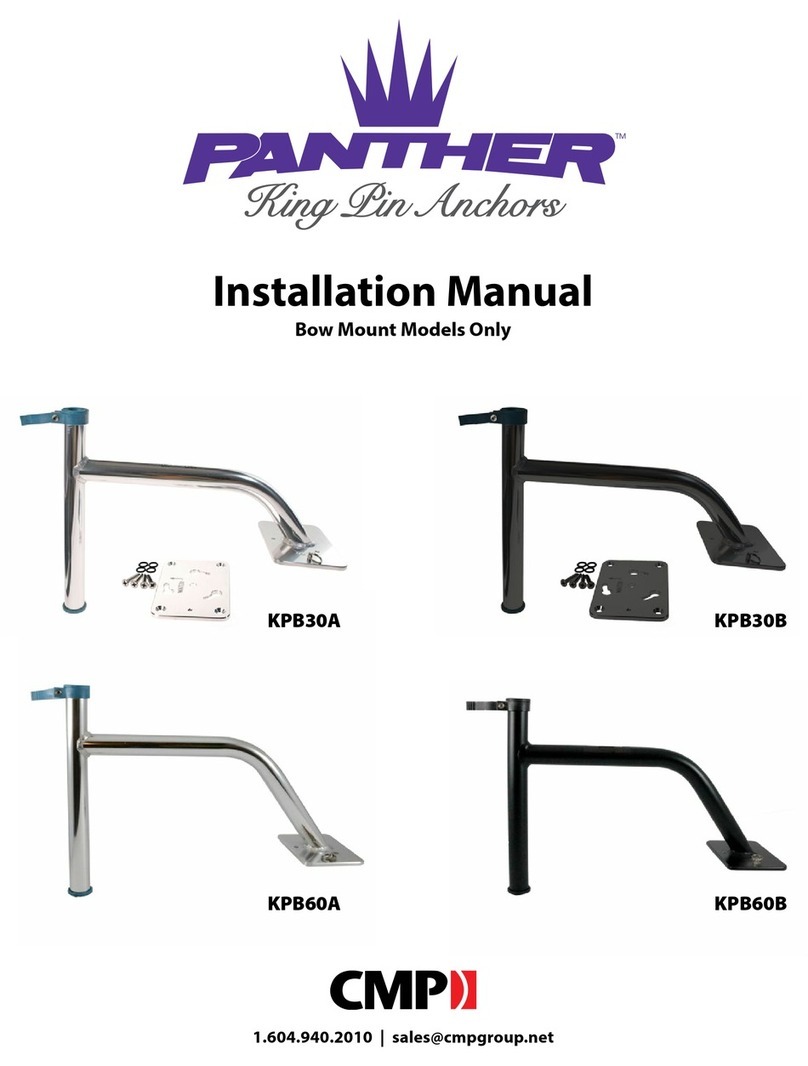
CMP
CMP Panther KPB30A installation manual

Dowco
Dowco ALUMACRAFT BOAT COVERS WITH COVER-LIFT... installation instructions
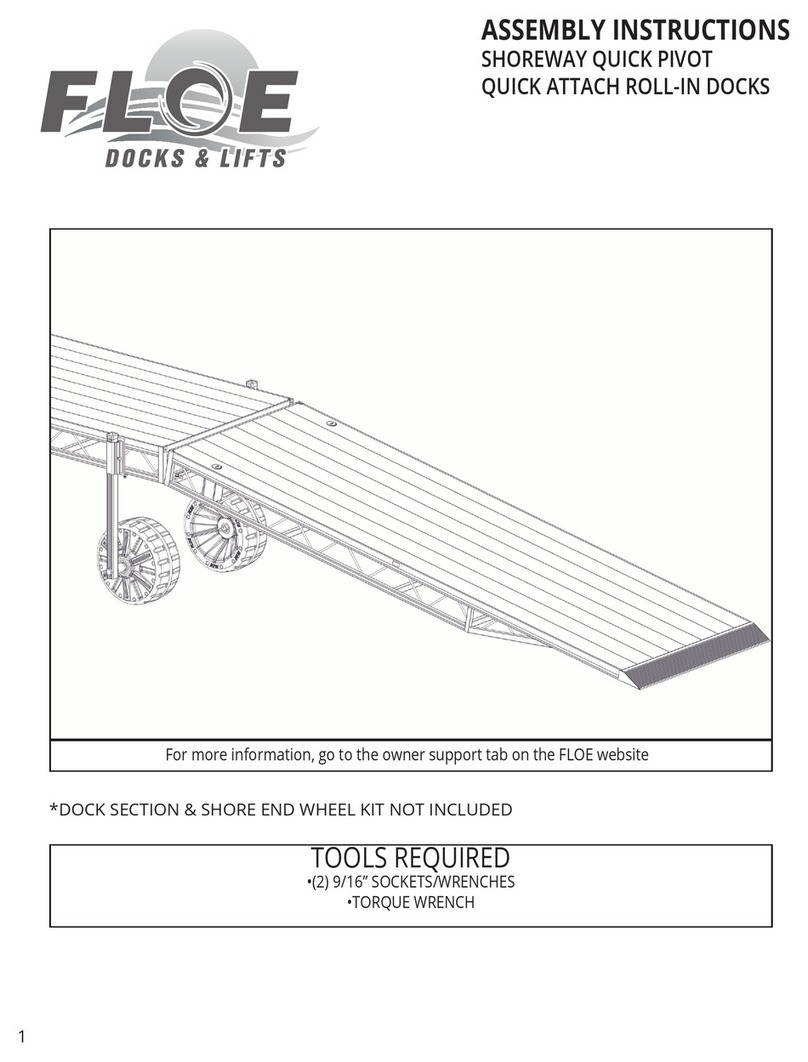
Floe
Floe SHOREWAY QUICK PIVOT Assembly instructions
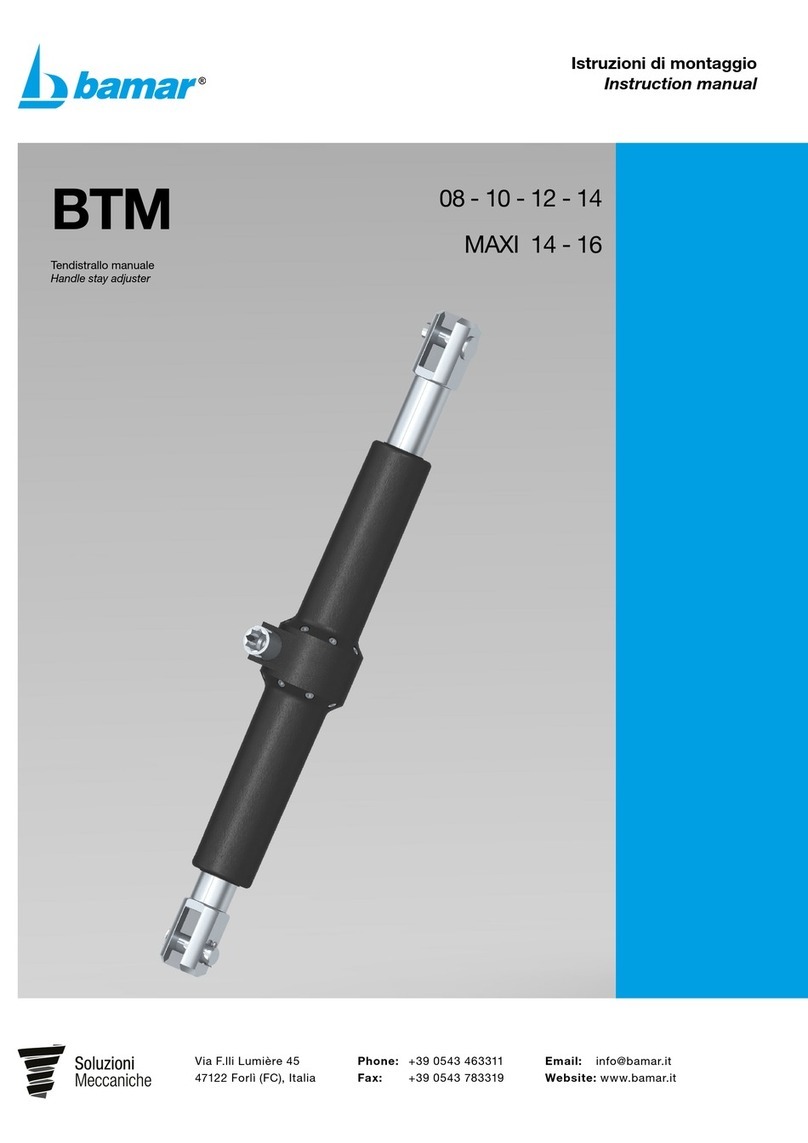
Soluzioni Meccaniche
Soluzioni Meccaniche bamar BTM Series instruction manual
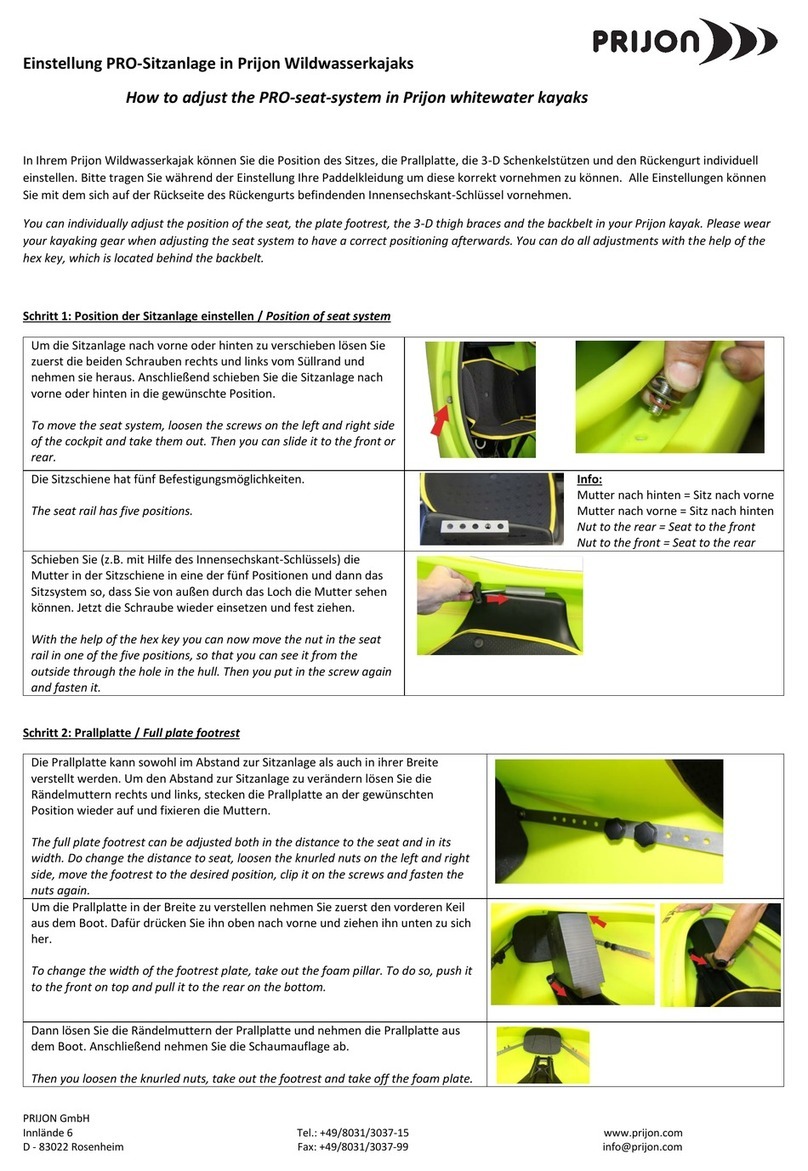
PRIJON
PRIJON PRO-seat-system How to Adjust
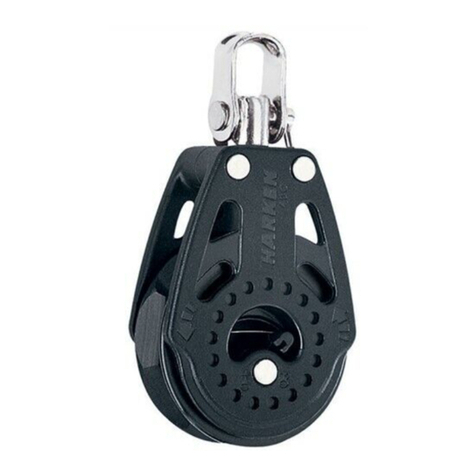
Harken
Harken 2608 Online instructions
